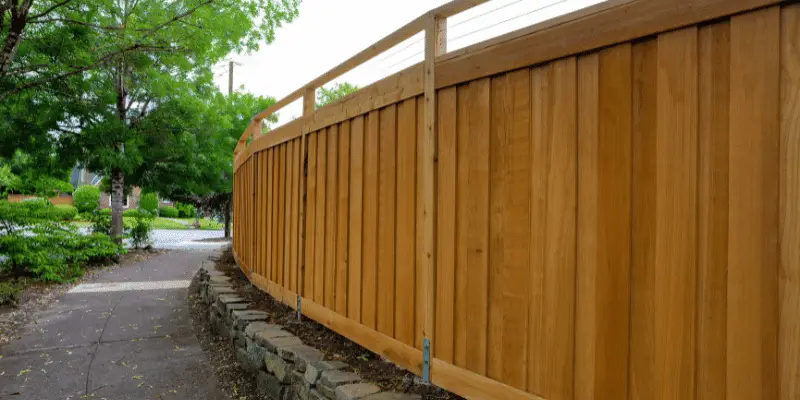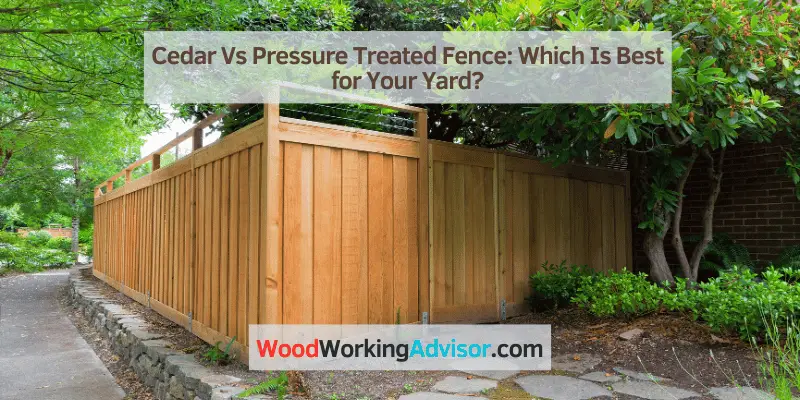When deciding between Cedar and pressure treated fence, consider longevity, maintenance requirements, and aesthetics. Cedar offers natural beauty and decay resistance, but requires more maintenance.
Pressure treated wood may last longer and need less maintenance, but lacks the attractive look of Cedar. Both options have their pros and cons, so it depends on your preferences and budget. We’ll explore the differences between Cedar and pressure treated fences to help you make an informed decision.
Whether you prioritize durability, appearance, or cost-effectiveness, understanding the unique characteristics of each type of wood will guide you towards the best choice for your fence project.
Cedar Vs Pressure Treated Fence: An Overview
Durability And Longevity
When it comes to choosing the right type of fencing for your property, considering the differences between cedar and pressure treated fences is essential. Both options have their own unique qualities and characteristics that can impact the overall look, durability, and maintenance of your fence. In this overview, we’ll delve into the pros and cons of cedar fencing and pressure treated fencing to help you make an informed decision for your outdoor space.

Pros And Cons Of Cedar Fencing
Cedar fencing offers a timeless, natural appeal that enhances the aesthetic of any property. Its distinct grain patterns and warm hues create a charming and inviting atmosphere. Within the realm of durability, cedar is naturally resistant to rot, decay, and insect infestations due to its innate oils and preservatives, making it a long-lasting and low-maintenance option for homeowners.
- Pros of Cedar Fencing:
- Natural beauty and aesthetic appeal
- Durable and resistant to rot and decay
- Low maintenance
- Cons of Cedar Fencing:
- Higher initial cost compared to pressure treated wood
- May require regular staining or sealing to maintain appearance
- Less resistance to extreme weather conditions
Pros And Cons Of Pressure Treated Fencing
Pressure treated fencing is a popular choice due to its affordability and resilience. The treatment process involves infusing wood with preservatives that protect it against rot, decay, and insect damage, making it an ideal option for withstanding harsh environmental conditions. Furthermore, pressure treated wood tends to have a longer lifespan than untreated wood, offering homeowners a durable and cost-effective solution for their fencing needs.
- Pros of Pressure Treated Fencing:
- Cost-effective option
- Durable and resistant to rot, decay, and insects
- Available in a variety of finishes and styles
- Cons of Pressure Treated Fencing:
- Initial chemicals used in the treatment process may pose environmental concerns
- Can require periodic maintenance such as staining or sealing
- Potential warping or splitting over time
Comparing Cedar and Pressure Treated wood for fences, Cedar’s natural durability and longevity make it a top choice. Its resistance to rot and decay minimizes maintenance needs while providing a sustainable, attractive option for long-term fence structures.
Durability and Longevity
When it comes to choosing the right material for your fence, considering the durability and longevity is crucial. Both cedar and pressure treated fences have their own benefits in terms of lifespan, structural integrity, and resistance to decay. Let’s take a closer look at the lifespan of these two popular fencing options.
Lifespan Of Cedar Fencing
Cedar fencing is widely known for its natural durability and resistance to rot, decay, and insects. The inherent properties of cedar wood, such as natural oils and tannins, contribute to its longevity. With proper maintenance and care, a cedar fence can often last upwards of 15 to 30 years, making it a durable and long-lasting option for homeowners.
Lifespan Of Pressure Treated Fencing
Pressure treated fencing, on the other hand, is specifically treated with preservatives to enhance its resistance to decay, termites, and fungal decay. This treatment process significantly extends the lifespan of the wood. Typically, pressure treated fences can last anywhere from 20 to 30 years, making them a durable and long-lasting choice for outdoor structures.
In comparing the two options, it’s clear that both cedar and pressure treated fencing offer impressive durability and longevity. However, understanding the specific lifespan of each material can help homeowners make informed decisions when selecting the right fence for their property.
Maintenance And Upkeep
Maintenance and upkeep are essential factors to consider when choosing between cedar and pressure-treated fences. Both options require care and attention to ensure longevity and durability. Understanding the specific maintenance needs of each type of fence is crucial in making an informed decision.
Care And Maintenance For Cedar Fences
Cedar fences are known for their natural beauty and durability. To maintain the appeal and structural integrity of cedar fences, proper care is necessary. Here are some key maintenance tasks for cedar fences:
- Regularly inspect the fence for signs of damage, rot, or insect infestation.
- Apply a protective sealant every 2-3 years to enhance the wood’s resistance to moisture and decay.
- Clean the fence periodically to remove dirt, debris, and mildew using a gentle cleaner and soft brush.
- Trim any nearby vegetation to prevent overgrowth that can cause moisture retention and damage to the wood.
Care And Maintenance For Pressure Treated Fences
Pressure-treated fences are treated with chemicals to resist rot, decay, and insect damage. However, proper maintenance is still essential for maximizing their lifespan. Consider the following care and maintenance tips for pressure-treated fences:
- Regularly inspect the fence for signs of damage, particularly at the ground level where moisture can accumulate.
- Apply a water-repellent stain or sealant every 2-3 years to enhance the fence’s resistance to moisture and UV damage.
- Clean the fence using a mild detergent and water to remove dirt, mold, and mildew, especially in shaded areas.
- Ensure proper drainage around the fence to prevent water accumulation near the posts and base.
Environmental Impact
When considering installing a fence, it’s important to weigh the environmental impact of different materials. Cedar and pressure-treated wood are two popular choices for fences, each with its own set of benefits and drawbacks. Understanding the sustainability and environmental implications of these options can help you make an informed decision that aligns with your values and green initiatives.
Sustainability Of Cedar Fencing
Cedar fencing is known for its sustainability due to the renewable nature of the cedar tree. Cedar grows relatively quickly, making it a highly renewable resource for fencing materials. The harvesting of cedar for fencing purposes is generally managed in a sustainable manner to ensure that it remains an abundant resource for future generations.
Environmental Implications Of Pressure Treated Fencing
Pressure treated fencing, on the other hand, comes with environmental concerns. Pressure-treated wood is treated with chemicals to improve its durability and resistance to decay. The most common treatment chemical, chromated copper arsenate (CCA), has raised environmental and health concerns due to the leaching of arsenic into the soil and water over time. Despite efforts to phase out CCA, alternative treatment chemicals also raise environmental and health-related issues, making pressure-treated fencing a less environmentally friendly option compared to cedar.
Cost And Budget Considerations
Cedar and pressure treated wood are popular choices for fencing due to their durability and ability to resist rot and insect damage. When deciding between the two options, cost and budget considerations play a significant role in the decision-making process. Let’s compare the cost implications of cedar and pressure treated fencing to help you make an informed choice.
Initial Cost Of Cedar Fencing
Cedar fencing typically comes with a higher initial cost compared to pressure treated fencing. This is primarily due to the fact that cedar is naturally resistant to rot and insect infestations, eliminating the need for additional chemical treatments. The aesthetic appeal and longevity of cedar also contribute to its higher price point. However, despite the higher initial investment, cedar fencing may prove to be more cost-effective in the long run due to its low maintenance requirements and longevity.
Initial Cost Of Pressure Treated Fencing
Pressure treated fencing generally involves a lower initial cost when compared to cedar fencing. The wood is treated with preservatives, making it resistant to decay, rot, and termites. The treatment process also helps in extending the lifespan of pressure treated wood. While the upfront cost is lower, it’s important to factor in the long-term maintenance and potential replacement costs associated with pressure treated fencing, as regular maintenance and treatments may be required to preserve the wood’s integrity.
Frequently Asked Questions Of Cedar Vs Pressure Treated Fence
What Are The Benefits Of A Cedar Fence Over A Pressure-treated Fence?
Cedar fences are naturally resistant to rot and insect damage, making them durable with minimal maintenance. Additionally, their natural beauty and aromatic scent add aesthetic value to the property. Pressure-treated fences, however, may require regular treatments to maintain their resistance to decay.
Which Fence Type Is More Eco-friendly, Cedar Or Pressure-treated?
Cedar is considered more eco-friendly compared to pressure-treated wood, as it is a renewable resource that requires minimal processing. Cedar also decomposes naturally, posing less harm to the environment, while some pressure-treated woods contain chemicals that may leach into the soil over time.
Are There Cost Differences Between Cedar And Pressure-treated Fences?
Initially, pressure-treated fences may seem more budget-friendly. However, when considering long-term maintenance and replacement costs, cedar fences often prove to be more cost-effective due to their durability and natural resistance. Investing in a cedar fence can ultimately save money in the long run.
Conclusion
When deciding between a cedar or pressure-treated fence, weigh the pros and cons carefully. Both options offer durability and aesthetic appeal, but suitability depends on individual needs. Consider factors like maintenance, cost, and environmental impact before making a decision. Whichever you choose, a well-built fence will enhance your property’s value and provide security for years to come.



3 thoughts on “Cedar Vs Pressure Treated Fence: Which Is Best for Your Yard?”